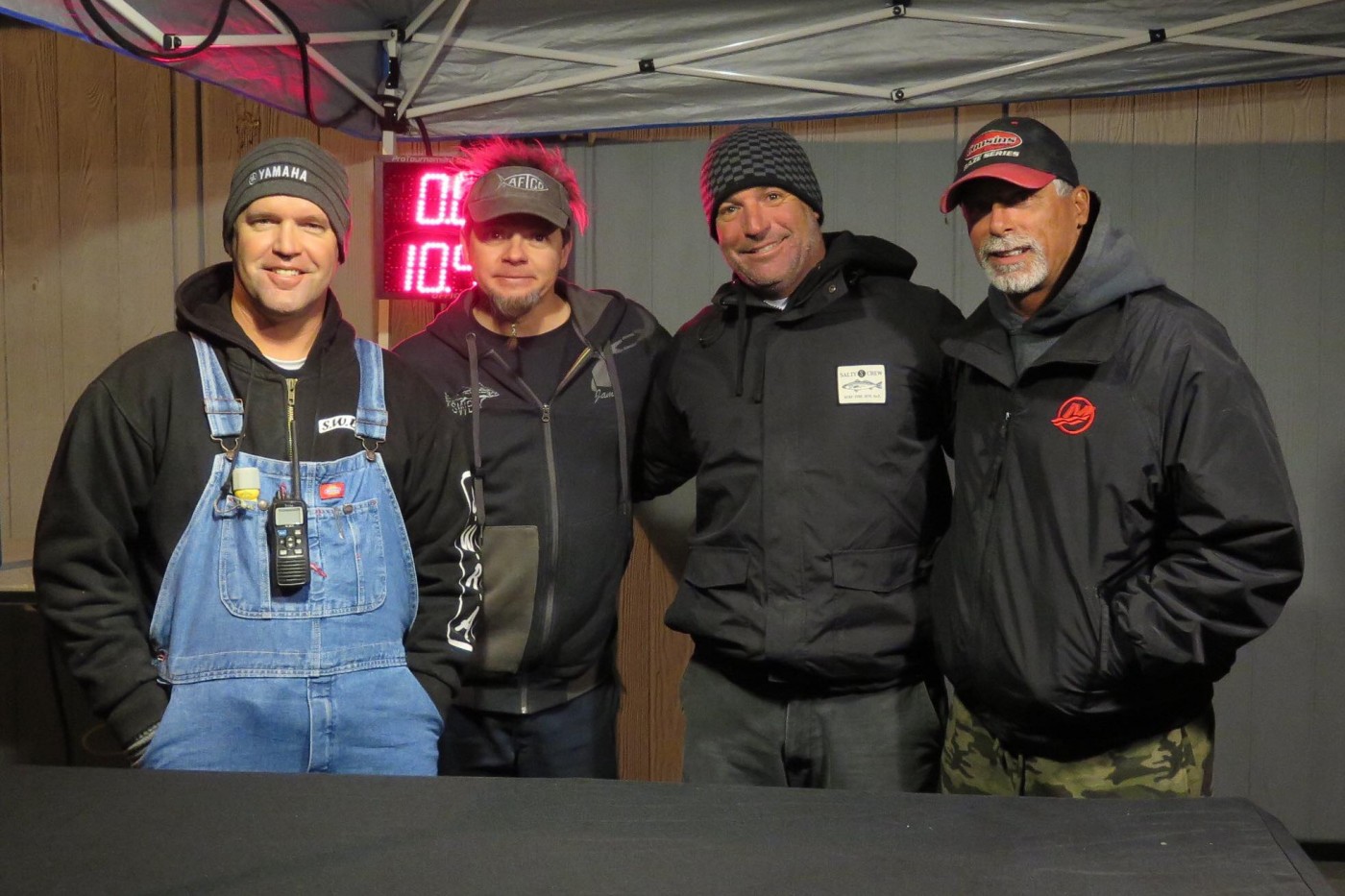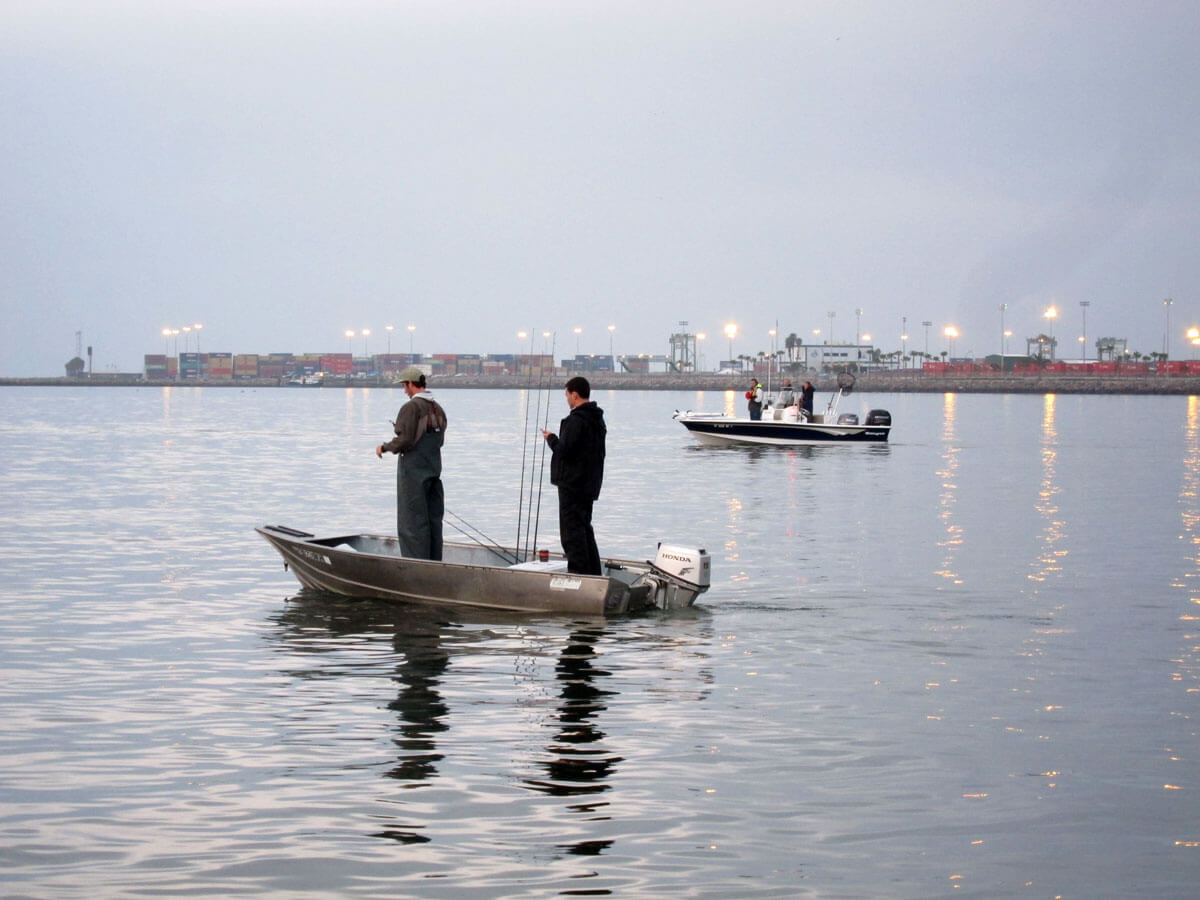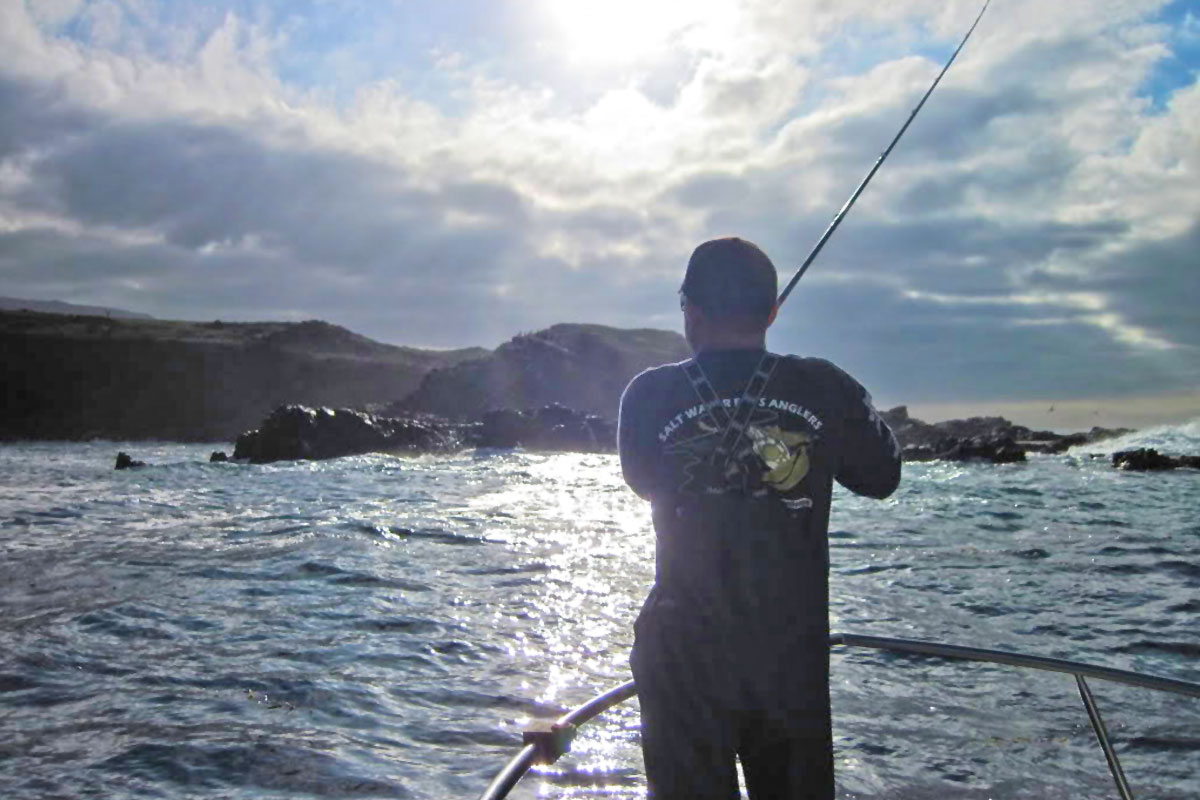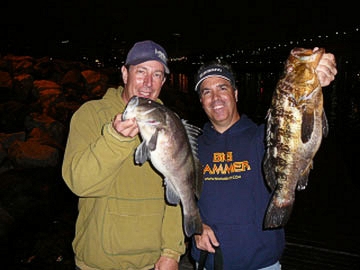Kicker Jigs: Color, Action & More
The Kicker Jigs family of Iron include Candyman and Iron Man Lures. Together they offer anglers a diverse array of colors, shapes and sizes to choose from.
Color, Action & More…
Mention the word ‘iron’ to a west coast fisherman and many pictures immediately come to mind. Long rods swinging early summer barracuda over the rail on sport boats, boiling yellowtail leaving truck tire-sized swirls around an accurately presented scrambled egg iron, moments before line starts flying off a tight spool. But mention throwing iron for calicos and you may get an odd look or two. For many veteran anglers this technique was old decades ago. But to many just getting into the sport of inshore bass fishing, the thought of hurling full sized surface iron on traditional equipment is as foreign as an old Dix ‘Baja Bones’ Jig!
Over the last several years, improvements in tackle has made sending a surface iron 40+ yards dozens of times over in a day possible for mortal man. Rod actions have been refined, and model selections increased, to not only offer lure specific rods, but also the ability to customize a model to anglers’ individual needs. Rod weights have come way down and components get better with each year. Reels cast better than ever, and the mechanical advantage offered now on some models can make quick work of larger quarry. Lines have become user-friendlier, through not only the blending of materials, but the sheer selection offered to the angler!
But with all that being said, it all comes back down to the thing on the end of the line, and the operator on the other. I was enlightened a few years back over at Catalina Island fishing with Ben Florentino. Having been a fan of casting any type of lure I jumped at the chance to throw some of his higher end tackle. Prior to this I had caught many Calico Bass on the iron, but on this particular day something very different happened and it remains in my mind like it happened yesterday. We had been fishing for a while, catching fish here and there on the usual lead head swimbait combinations. Some Calicos were tight to the beach while others positioned themselves in random pockets of the kelp. Fishing was a slow pick, with not a whole lot in the way of current or good off-colored water, which traditionally helps a Calico Bass bite to develop.
After some time Benny put down his swim bait rig and began long casting his surface iron both parallel to the beach and at an angle, from the inside out. After several minutes of casting and retrieving I hear the handle turns of Benny’s reel increase in RPM’s dramatically followed by a “Did you see that”!? He had just had a large Calico Bass come up and take a swipe at his Kicker 25 surface iron in Senorita Fish color. The very next cast I hear the same thing followed by “There he is”! Soon a solid three-pound bass was swung over the rail. I kept at it with my swimbait, now casting with a little more inspiration, distance, and accuracy. A couple casts later I hear Benny yelling “look at that one”! as another calico chased his iron right to the boat. Now I was a little more interested, since the area we were fishing looked relatively dead. Ben had found a way to get these fish active. A couple dozen casts later and two photo worthy fish; one being well over 6 pounds I’d seen enough. I picked one of Ben’s iron rods out of the rod rack.
Now I was playing the same game and was able to observe what was going. We were in 15 to 22 feet of water with little to no current, retrieving our irons at a fairly fast clip. As I cast mine out I ‘d watch in almost a trance, as Ben’s iron came swimming back to the boat. The first thing I noticed was the great distance the jig covered between kicks and the rhythm in which the jig remained. It was clear from that moment there was something happening entirely different than the usual cast and retrieve methods. However, I couldn’t quite put my finger on it.
Meanwhile I was casting, focusing on not back lashing, properly feeding the line back onto the spool, and not dropping the combo I couldn’t afford to replace! At some point I heard a big BOOOSZHSZHSZH!!!, followed by some quivering in my line and slight resistance in the reel and rod. I looked up to see what looked like a bucket of water that had just been dumped where my lure was, I said, “Wow, I just scared the crap out of that seal”, seeing some brown coloration amidst all the foam. Benny’s reply, “That was no seal bro”! I sat there for a second, kind of dumbfounded as I realized I had just had a close encounter with a very large bass
This got my curiosity stirred up more to the whole process and reasoning, than any interest in actually landing one. I paid more attention to what was happening rather than trying to make it happen. This was something special, perhaps even a bit unorthodox and I was going to take in as much as possible. We had just come across an area devoid of life, and turned it into to a full-on street mugging session and we were the ones getting mugged.
Low Frequency Sound Waves
The first thing that I noticed was the jigs ability to ‘call’ fish in from not only the depths, but also great distances. You could tell these fish were sprinting to the jig not just vertically, but laterally as well. We were well away from any cover such as kelp stringers and boiler rocks. We were off the beach and over sand. These fish were not suspending, they were running the jig down from a long ways away, but why? That same cadence kept me mesmerized, kick-kick-thump, kick-kick-thump. It was the low frequency sound waves emitting from the jig as it pressed water away from itself in a rhythmic fashion. These fish were hearing or better yet, ‘feeling’ this jig swim through the water and were drawn into it, much as I was watching it. As they approached, the profile of the jig came into visual range feeding another sense in their curiosity, now fast approaching predatory response. Once in visual range, the action of the lure in synch with the sounds waves emitting from each kick and thump further amplified the response from the bass. The ‘Kicker’ to seal the deal was a meal-sized jig, brightly painted and finished off with a pair of painted eyes, offering a bull’s eye target for the landing. Whomp!
Now you may say, ahhhh that’s just a good old iron bite. Perhaps, but I have seen too many breaking fish eat a jig simply because they were in a feeding mode or the conditions were right. This day neither was the case. These fish were in a negative feeding mode in poor conditions. The speed at which the jig was being pulled through the water told me this was more than a reaction bite, this was appealing to a fishes senses in a manner few experience. It was almost like cheating. The fish seemed forced to follow and do something, whether it was just follow, roll, swirl, swat, or eat the jig. We had appealed to senses few, if any other lure types can!
You could make an argument that a crank baits rattles could have the same effect or a spinner baits blade thump could insight the same response, but I’d have to disagree in this case. Those types of baits simply cannot be pulled through the water at the speed of a winding Trinidad 16’s 6:1 gear ratio spooled to the brim. It’s totally different. These are low frequency sound waves traveling longer distances with greater effect. I remember telling Benny’ “You’re calling them in’! He just laughed, (probably thinking) “whatever guy”.
After a while I was able to get into the whole groove of the thing, but witnessing the response elicited from the jig stayed with me more than the fish I caught that day. I was hooked!
Since that day I look at iron, and iron fishing a whole different way and so should any tournament angler. It is a tool, and a very unique one at that. Two lures Benny uses are the Kicker 25 and Candyman lights. These two lures fish entirely different and both have their place. The Kicker 25 that we were throwing that day has a slimmer profile and is a bit narrower. This jig seems to work well with a medium-fast, to fast pace. Where as the Candyman gets in it’s groove from a slow to medium fast retrieve. What pace you ask? Well, only time on the water and paying attention will tell you that. I can say this, that after seeing Ben’s lure swimming in my mind, I had a mental image of what the lure needed to look like. My reels and rods are different from Ben’s, so attention was needed to re-create that same action on different equipment. When I got it though, it was game on once again.
Try experimenting with different cadences and watch your lure as it swims to the boat. Invest in some quality-polarized sunglasses. A light amber or rose color lens increases contrast allowing your eyes to pick up the jig from greater distances. Black out the underside of your hat to cut down glare. All this will allow you to see things you hadn’t noticed before this will help believe me. You will see the iron come and go in and out of its prime retrieve rate. This rate may have a broader range some days and narrower on others. Let your gut tell you what the pace is, get in tune with your surroundings and feel your way into a bite.
Color???
Where does color fit in all of this? Good question. Too much has been said while not enough has been said about color. I feel that when it comes to color in iron you can toss out some of traditional thinking applied to plastics and other baits. The jig is being retrieved at a good clip remember? It’s the action thump and kick that gets the fishes attention. Johnny Calico didn’t just swim the 50-meter medley to get to your jig because it looked like a sardine. But now that you’ve got him window shopping it’s time to close the deal. I match baits based on watercolor and clarity most of the time. This can coincide with the match the hatch concept especially in clear water, but not always. Baitfish often adapt their coloration to fit their surroundings. If you stand back and look at your jig from the standpoint of “does it look like it belongs here?” you will see some semblance. Conversely if you are looking to contrast you need to look at it from the angle of “does it contrast well”.
Benny Florentino: Hand selects, from the wall of color, one of Kicker’s Candyman’s newest colors… the “Nile Perch”.
This again is something that can’t be expressed in simple lists of colors, but has to be felt the day of. Look at the color schemes and paint jobs on the Iron Man Lures and Kicker Jigs. There are not too many muted or fully subdued colors. These are deal closers, made for different conditions. Look at the black tails on some of the new Kickers and Candyman’s, those are bulls eyes, meant to keep the bass locked on to the business end of an iron. When selecting iron, give yourself at least a small range of colors to choose from, so once on the water you are not locked in to one color direction. Select with your gut, not always with what you’re told. What works for one person may not work as well for you. Benny preaches confidence that confidence begins with lure selection.
Equipment
Traditional iron tossing equipment hit its apex with 10+ foot glass rods on Newell reels some time ago. Nowadays anglers have much better selections in not only composite rods, but pure graphite as well. The need for 9, 10, and even 11-foot rods on small skiffs is just not necessary.
Chuckin’ Iron: Long rods may still be the standard slingers on party boats throughout the Southland, but competitive anglers fishing from smaller boats, closer to the shoreline, rely on shorter rods for accuracy.
It may have a nostalgic feel and you may get a few more yards, but the awkwardness and inaccuracy of the super long rod really makes it somewhat impractical for the tournament angler or weekend angler for that matter. An angler can be much more accurate with an 8 foot rod which is critical when target casting. It is also a lot easier to control a fish close to the boat [where many bites take place] on a shorter rod. Shorter rods are also a lot less fatiguing after a days worth of casting. Traditional rod actions were very parabolic in the past. This allowed for smooth accelerations into and out of a cast. It also took the shock and stress out of ‘loading’ up a rod, making it easier on the angler. But modern materials and state of the art actions have brought about more ‘action’ into the rod. With extremely light rods such as the Calcutta and Teramar series of jig sticks, (which by the way do have some glass in them) anglers can get more out of a rod than just a buggy whip type iron launcher. Hook sets are now surer, rods now load much easier due to progressive tapers, and the weights have been cut down immensely. All this benefits the modern angler who is willing to take a leap and get in on some chuckin.
When it comes to reels the one concept to keep in mind is line diameter versus spool capacity. Think of it like this, every time you turn the handle with a full spool you retrieve two feet of line. Make a long cast, dump down half the spool of line and turn the handle. You are now retrieving 14 inches of line per handle turn. Now if you retrieve that jig at the same rpm all the way back to the boat the lure is in a constant state of acceleration regardless of how steady you wound. You have to compensate the entire retrieve and that is not easy to do over 40+ yards. This small nuance can be the difference between catching a fish or two and lighting them up! When selecting a reel for iron tossing keep in mind the size of the line you will be using. The heavier the line the larger the diameter, the less yardage you will get on the reel. Benny fishes with extremely full reels to take advantage of the reels retrieve. All this being said you should have enough line on your reel to maintain a consistent retrieve of line regardless of the length of cast. Keep in mind too that the larger diameter lines don’t like to bend around small spools, but it does produce some really nice slinkys!
Braided lines are working there way into the iron arenas at varying levels. I have seen people fish 50 pound braid on Trinidad 14s with great success. But be warned, the larger iron and small diameter of braid can produce some of the wickedest backlashes ever. A more parabolic rod offers a more forgiving start-up during the cast and let’s the fish ‘climb on’ against the no stretch properties of braid. I would recommend no less than 50 pound braid for tossing iron, with 65 pound being preferred. The reason is simple, braid losses strength rapidly when frayed; backlashes and normal wear and tear will cause small fraying to occur regardless. If you sail an iron and get an early backlash the chances of snapping off that lure are much greater on a thin braid than one of a little larger diameter. POW ! ! !
Perfecting your Cadence
Keep in mind also when retrieving a jig the angle at which the rod points towards the water and the jig itself. Bass will nudge, push, swat and roll on the iron, sometimes several times before they decide to eat it. It’s important to keep the rod relatively low to the water, and at an angle that allows for some rod bend but not too much. If your rod is facing perpendicular to the jig, the bend of the rod may flick the iron out of the strike zone if a fish gets momentarily stuck. If the fish does commit and you are 90 degrees off the fish, you will need to wind in an excessive amount of line prior to setting the hook. This is the time when a fish will be shaking his head and most likely will result in a thrown hook. Remember you may be 40 yards away or more! Conversely if you point the rod directly at the jig upon retrieve you are fishing off the reel and have eliminated the rods action all together. This can result in prematurely sticking a fish in a bad location and alerting the fish to potential danger. It also can result in a hand slipping off the reel handle, as there is no rod action to absorb the strike. There is a sweet spot and everyone needs to find his or hers. Another trick to keep in mind is the ‘flow.’ As you retrieve a jig from a pitching boat those up and down boat movements transmit in to the lure, creating acceleration points on the ups and periods of deceleration as the boat falls. An angler who is ‘rigid’ will be accentuating those effects. This is not necessarily a good thing or a bad thing, just something to be aware of. I’ve seen times where this made a big difference. I have seen situation where you needed to hold the rod and reel loosely to compensate for the rocking of the boat acting as a dampener between the boat and the jig.
I hope this article has given you a little more insight into the art of fishing the iron. There are no set-in-stone ways to fish the iron. Try applying your style to some of these ideas and see how things go, you’ll probably come up with t a few of your own. With a little tenacity and an open mind I think you will be pleasantly surprised! Like anything else throwing iron takes some practice, but the rewards can be awesome!
SS Candyman: comes in a variety of bassy colors. This version, ‘Pumpkin Rita’ is one of many within the Calico series. Click on the above image to view kicker’s color chart.
















Got something to say?